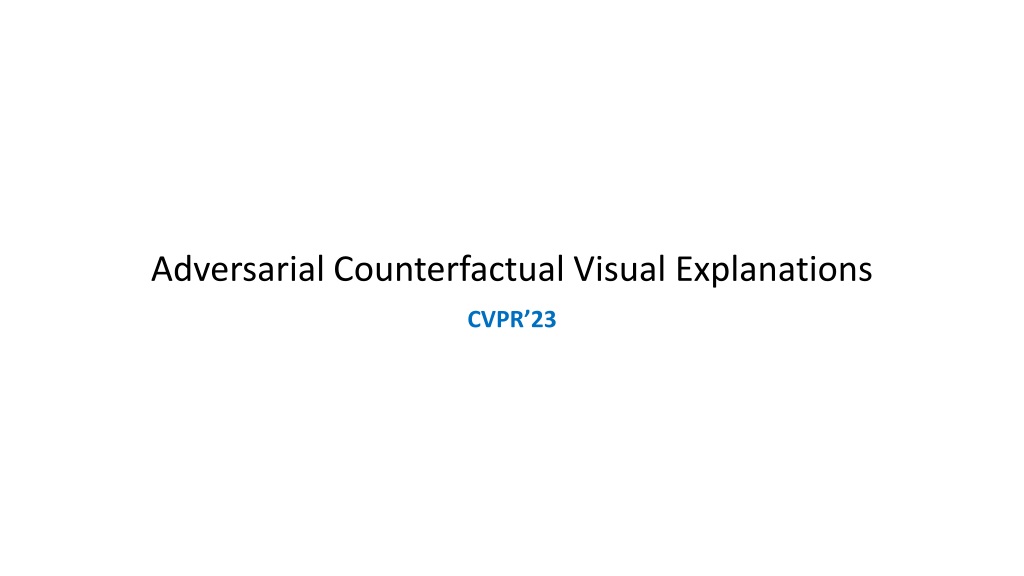

0 likes | 10 Views
Adversarial attacks and counterfactual explanations play crucial roles in understanding and improving machine learning models. By leveraging a 2-step filter technique, this study aims to transform adversarial attacks into counterfactual explanations without the need for retraining the model. Utilizing Denoising Diffusion Probabilistic Models (DDPM) and post-processing methods, the approach enhances the classifier's robustness and maintains image structures while explaining model predictions. Evaluation metrics include flip rate, mean number of attributes changed, face verification accuracy, face similarity, and more.

E N D
Adversarial Attack vs Counterfactual Explanations • Adversarial attack and CFEs both aim to flip the class by tweaking the model • Adversarial attacks are used to identify the limitation of a model whereas CFEs are used to explain why a model made a particular prediction • Real data + perturbation = adversarial sample • Perturbation is mostly noise and not actionable and not understandable for image data
Adversarial Attack vs Counterfactual Explanations • Adversarial attack CFE with post processing • CFE original CFE
Issues to solve • If you want to make a model robust, you have to change the model. That means training the model with adversarial samples. • The adversarial samples are unable to be used as CFEs • But one trait of adversarial attack is desired for CFE generation: -- -- Adversarial samples are very close to the original sample
Objective • Come up with a method to robustify the model without retraining it, without changing it • Transform the adversarial attacks to CFEs
Method • 2 step Filter technique • Pre-explanation generation: • Original input is (x, y) • The adversarial attack is x’ and target class is y’ (!=y) minimize • Filtering mechanism is designed to enhance the robustness of the classifier by removing/reducing the impact of perturbations or noise in the input data. Regular input Fil ter Adversarial attack Use it to create CFE • Filter improve the classifier's ability to generalize to unseen or adversarially perturbed examples • Bringing the pre-explications closer to the input images: • Post-processing technique. Applies changes to make the perturbed images as close to unperturbed images as possible
Pre-explanation generation • Filter design • Use Denoising Diffusion Probabilistic Models (DDPM) to suppress the impact of perturbations • Removing high-frequency information: common traits of adversarial attacks • high-frequency perturbations could change the classifier’s decision without being actionable or understandable by a human. Phase 1 Phase 1 • Producing in-distribution images without distorting the input image • This property seeks to maintain the image structures not involved in the decision-making process as similar as possible Phase 2 Phase 2 Use DDPM Use DDPM
DDPM t = T t = 0 t = 1 t = 2 t = 3 t = 4 t = 5 …….. - - Multiple iterations
Pre-explanation generation • Filter design Use DDPM Use DDPM
Bringing pre-explanations closer to input images • Postprocessing phase • The reconstruction will somehow preserve the overall structure of the image. • A post-processing phase could help keep irrelevant parts of the image untouched • Example: The reconstruction may change the hairstyle while targeting the smile attribute. Since hairstyle is presumably uncorrelated with the smile feature, the post-process should neutralize those unnecessary alterations
Bringing pre-explanations closer to input images • Postprocessing phase • Create a mask • Threshold(Dilate(reconstructed image – input image)) • Merge the CFE’s ROI with the ROI of the mask • Merge the input with the uncorrelated part of the mask Dilation: expanding the region
Evaluation Metrics • Flip Rate: Is the CE classified as the targeted label. • Mean number of attributes changed (MNAC): Measures the smallest number of traits changed between the input-explanation pair (Sparsity) • Face Verification Accuracy (FVA): Does the CFE change the person? • Face Similarity (FS): cosine distance between the encoding of image- counterfactual pairs • COUT measures the transition probabilities between the input and the counterfactual • FID measures Realism of counterfactual images • sFID contains multiple iterations of FID to remove any bias
Diffusion model as an image generator t = T t = 0 t = 1 t = 2 t = 3 t = 4 t = 5 …….. With embedding Amplify the difference and keep adding it to the generated image embedding Without embedding Cat on a hat